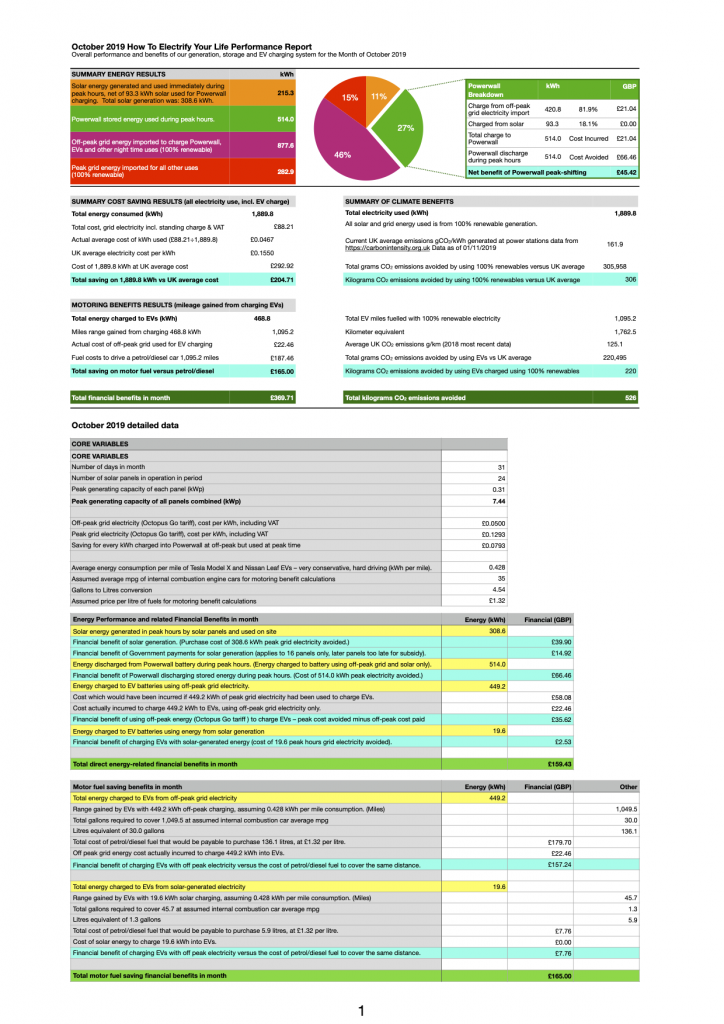October 2019 was a pretty dull month, with the Met Office reporting only a miserable 90.1 hours of sunshine in our region, so it wasn’t great for solar generation. The 308 kWh produced are more or less in line with our expectations for the solar 24 panels we currently have in service, pending the installation of the final 8 panels when the ceramics studio is built in the next few months. Obviously, we expect significantly better production in the brighter months (roughly March to September), further enhanced by the final solar panels being commissioned.
Nevertheless, the system did an efficient job of using super-cheap electricity to charge the domestic storage battery (Tesla Powerwall) and the two electric cars (Tesla Model X and Nissan Leaf) in the off peak hours, and then using the stored energy, both around the house during peak hours and for powering 1,095 miles of EV driving. Taking into account both our own solar generation and peak-shifting (using stored cheap electricity during expensive peak hours) and motor fuel cost avoided, we saved £369.71 in October 2019.
All the electricity we consume, both from our own solar generation and our grid imports from Octopus, is 100% generated from renewable sources. This enabled us to save 526 kg of CO2 emissions in October 2019, taking into account both domestic electricity usage (versus UK average CO2/kWh for generation at power stations), and in EV driving versus the CO2 petrol/diesel cars would have emitted when covering the same distance. Details are in the downloadable monthly report at the bottom of this page.
We use the ‘Octopus Go’ tariff to make much of the financial saving and their 100% renewable sourcing policy enables us to make significant emissions reductions, even in a dull month with not much sunshine. Disclosure: If you sign up to any Octopus Energy tariff via the link provided, both you and we will each get £50 off our electricity bills.
Our total consumption in the month of October was 1,899 kWh, of which:
- 215 kWh (11% of 1,889) was solar, generated in peak hours, and consumed immediately, also in peak hours, generally around the house, or for charging the batteries in our two EVs.
- A further 93 kWh of solar generation went into charging the Powerwall battery (see below).
- This portion of the solar power we generated was therefore ‘delayed’ consumption. To avoid double-counting, we account it under the next item, only when it is discharged from the Powerwall at a later point and consumed.
- 514 kWh (27% of 1,889) was the stored energy discharged from the Powerwall, which was all used during peak hours. The stored energy came from the following sources:
- 93 kWh from solar (18% of 514);
- 421 kWh from off-peak grid electricity (82% of 514). The Powerwall is configured to avoid any consumption of peak electricity.
- 878 kWh (46% of 1,889) was off-peak grid energy, from 100% renewable generation. It was used as follows.
- 421 kWh of the off-peak grid energy (48% of 878) were used to charge the Powerwall at a cost of 5.00p/kWh. The Powerwall then discharged the stored energy for use in the house during peak hours, avoiding a cost of 12.93p/kWh, for a net saving of 7.93p/kWh. The month’s saving from this ‘peak shifting’ alone accounted for £45.42.
- 449 kWh of the off-peak grid energy (51% of 878) were used to charge the batteries on our two EVs. This equates to 1,049 miles of motoring.
- 8 kWh of off-peak grid energy (1% of 878) were consumed by other loads which were running during off-peak hours.
- 283 kWh (15% 1,889) was peak grid energy, from 100% renewable generation.
Our total bill from Octopus for imported grid energy was £88.21 including VAT. This was made up of £7.75 standing charge (31 x 25p) and £80.46 actual energy costs.
£88.21 was our total cost covering all of our domestic electricity use and 1,049 miles of EV driving. That’s a total of only £2.84 a day (£19.88 a week) for domestic electricity AND motor ‘fuel’.
The combined benefits of zero-cost solar generation, plus using the two car batteries and the Powerwall domestic battery to fill up with electricity during the dirt cheap 5p/kWh Octopus Go off-peak period, meant that our average cost of electricity overall was only 4.67p per kWh. This compares very strongly to the UK average cost of 15.5p/kWh.
Please note. Anne fired the pottery kiln eight times in the month. Each firing uses approximately 50 kWh of electricity. So roughly 8 x 50 = 400 kWh (21%) of our 1,889 kWh total consumption was for the ceramics business. It’s worth noting that this additional consumption would not apply in normal domestic premises which do not run an energy-intensive business on the same site.
The full monthly report is below. Please click on it to download a PDF from our cloud storage.
